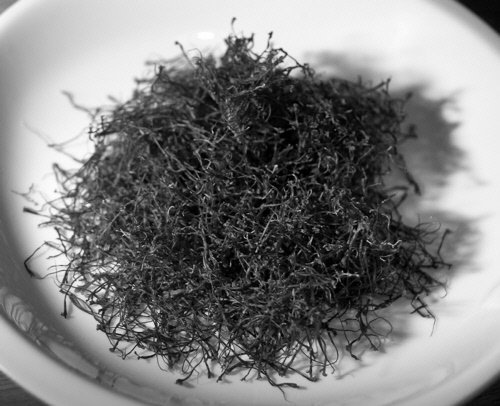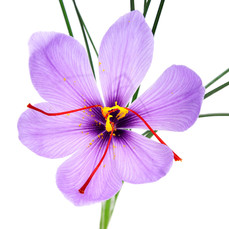Saffron, a popular and venerated plant already in antiquity until nowadays, but supposedly only a few know about its precious virtues. Famous persons like Alexander the Great and Cleopatra used it, the Greeks and the Romans cultivated it and used it for curing many diseases, perfumes, votive offerings, a food additive, colouring textiles, etc. After the fall of the Roman empire it disappeared, but the Moors reintroduced it to Europe. Especially after the Black Death, there was a huge demand for saffron, in particular because of the medicinal properties of this plant. At the same time other plant species like coffee, tea, chocolate and vanilla appeared leading to that the demand for saffron decreased and cultivation was limited to temperate regions like Spain, Italy and Greece.
In fact, saffron is a spice which derives from the plant Crocus sativus with Crocus having a Greek origin. According to Greek mythology, saffron originates from the love of the boy Krokos for the nymph Smilax who unfortunately also was the favourite of the god Hermes. Because of his jealousy, he transformed Krokos into the saffron crocus, while Smilax who preferred Krokos to Hermes, was transformed into the vine Smilax by Aphrodite such that they could grow together for eternity.
Cultivation of saffron in Sardinia started in the fifth century CE by monks at San Basilio who used it for liturgical purposes. After the eighth century CE saffron became known and appreciated in the whole island. The monks at San Basilio reportedly brought saffron to San Gavino Monreale in the Middle Ages and it is even documented by a notary in 1539 that a shoemaker bartered a quantity of saffron for a piece of skin in order to make a pair of shoes. As a matter of fact, cultivation of saffron at San Gavino Monreale is widespread and almost every family cultivates it.
Chiara lives at San Gavino and she kindly invited us to her house in order to talk about cultivation of saffron which she is particularly proud of. Since saffron was more or less unknown for all of us, she started with history.
Both she and her husband come from families of farmers for which it was natural to use plots for cultivation. Little by little they started approaching Slow Food since their way of thinking and protecting this type of agriculture was similar to theirs. In addition, the town where they live, San Gavino Monreale, was already the region in Italy with the highest production and the highest quality of saffron. Chiara also told us that her mother-in-law cultivated saffron and used to sell it to pharmacies which used it to relieve pain and against inflammations. Thus, when they started to sell their own saffron in 2000, they continued a familial tradition. Nowadays, they do this activity not only to get paid, but also in order to maintain a tradition which has become a part of their culture.
Now, 12 years later, the farm of Chiara and her husband is one of four farms participating in the Slow Food Presidium “Saffron of San Gavino Monreale” because the other growers aren’t interested in making a product which requires rigid analysis and controls. This includes following rules determined by Slow Food like avoiding fertilisers and weed killers, which will also guarantee the quality of the product to consumers.
In order to cultivate saffron, the bulbs are rigorously selected and planted in September and the harvest is done from the end of October to the end of November the year after, but the flowering only occurs for 2 weeks. The harvest is done manually and consists of cutting the flower below the sepals, using the thumb nail against the index finger.
After the harvest, the flowers are brought to a room where the red stems (see the photo) are removed manually requiring lots of patience and dexterity. Experts are able to pick 5-600 stems an hour.
Then, the stems are dried for about 3 hours before being conserved in an air-tight tin can because oxygen will degrade the quality of the dried stems. After some months, a sample is taken from the stems and subjected to a chemical analysis. If the sample contains a certain set of chemicals to required values, the whole production of saffron is approved and given a stamp of D.O.C., sealed in glass containers each containing 0.5 gramme each and conserved in a dry and dark place.
A yearly celebration of the precious saffron takes place in San Gavino Monreale during the harvest and preparation of the saffron.
Chiara, her husband and the other persons in this Presidium contribute to maintaining a culture which has been passed on from generation to generation, meaning that they conserving an ancient tradition.


